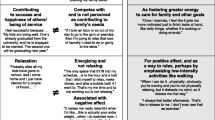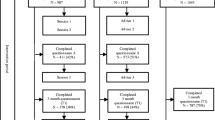Abstract
Purpose
This study aimed to determine the effects of action planning, risk perception, and message elaboration on the creation and quality of physical activity action plans. Risk perception was hypothesized as a potential moderator and elaboration as a potential mediator of the message framing-action planning relationship.
Method
Inactive adults (N = 180; 44% women; Mage = 29.7, SD = 9.92) were randomized to one of two framed action planning messages and responded to an online questionnaire pre- and post-message. Participants were asked about two types of risk perception towards action planning: emotional and plan creation risk perception. Post-message participants were asked about their elaboration regarding the message and presented with the opportunity to create action plans, which were scored for quality. A moderation model and a moderated mediation model were tested.
Results
Emotional risk perception moderated the message framing-action plan creation relationship. Individuals with increased emotional risk perception, as opposed to increased plan creation risk perception, were more likely to create an action plan when given a gain-framed message, as opposed to a loss-framed message. The moderated mediation model was not significant, but message elaboration predicted action plan creation. Individuals with greater message elaboration were more likely to create an action plan, regardless of the message frame.
Conclusion
Gain-framed messages may be more effective than loss-framed messages at promoting action plan creation in individuals with greater emotional risk perception. One’s elaboration of an action planning message may increase their likelihood of creating a physical activity action plan.





Similar content being viewed by others

Notes
The seven items had been previously tested with a different sample (N = 80) and an exploratory factor analysis was used to determine the factor structure of the measure. Two types of risk perception were found: emotional risk perception (Cronbach’s alpha = .90) and plan creation risk perception (Cronbach’s alpha = .64). A confirmatory factor analysis (CFA) confirmed the two factor model of the risk perception measure. The two factor model had excellent fit: χ2(21) = 358.12, p < .01, comparative fit indices (CFI) = .999, Tucker-Lewis indices (TLI) = .999, root mean square error of approximation (RMSEA) = .009 90% CI [.00, .08], and standardized root mean square residual (SRMR) = 0.035, and the items grouped into the two factors: emotional risk and plan creation risk.
Abbreviations
- CI:
-
Confidence interval
- ANOVA:
-
Analysis of variance
- OR:
-
Odds ratio
References
Carraro N, Gaudreau P. Spontaneous and experimentally induced action planning and coping planning for physical activity: a meta-analysis. Psychol Sport Exerc. 2013;14(2):228–48.
Rhodes RE, Pfaeffli LA. Mediators of physical activity behaviour change among adult non-clinical populations: a review update. Int J Behav Nutr Phys Act. 2010;7:37.
Schwarzer R. Modeling health behavior change: how to predict and modify the adoption and maintenance of health behaviors. J Appl Psychol. 2008;57(1):1–29.
de Vet E, Oenema A, Brug J. More or better: do the number and specificity of implementation intentions matter in increasing physical activity? Psychol Sport Exerc. 2011;12(4):471–7.
Michie S, Richardson M, Johnston M, Abraham C, Francis J, Hardeman W, et al. The behavior change technique taconomy (v1) of 93 hierarchically clustered techniques: building an international consensus for the reporting of behavior change interventions. Ann Behav Med. 2013;46(1):81–95.
Sweet SN, Brawley LR, Hatchell A, Gainforth HL, Latimer-Cheung AE. Can persuasive messages encourage individuals to create action plans for physical activity? J Sport Exerc Psychol. 2014;36(4):413–23.
Mistry CD, Sweet SN, Latimer-Cheung AE, Rhodes RE. Predicting changes in planning behaviour and physical activity among adults. Psychol Sport Exerc. 2015;17:1–6.
Latimer AE, Brawley LR, Bassett RL. A systematic review of three approaches for constructing physical activity messages: what messages work and what improvements are needed? Int J Behav Nutr Phys Act. 2010;7(1):36.
O’Keefe DJ, Jensen JD. The relative persuasiveness of gain-framed and loss-framed messages for encouraging disease prevention behaviors: a meta-analysis review. J Health Commun. 2007;12:623–44.
Duncan LR, Latimer AE, Rivers SE, et al. Not all messages are created equal: toward an integrated appraoch to message development. In: Harris PB, editor. Health behavior: new research. 1st ed. Hauppauge: Nova Science Publishers; 2013. p. 103–18.
Rothman AJ, Salovey P. Shaping perceptions to motivate healthy behavior: the role of message framing. Psychol Bull. 1997;121(1):3–19.
Gallagher KM, Updegraff JA. Health message framing effects on attitudes, intentions, and behavior: a meta-analytic review. Ann Behav Med. 2011;43(1):101–16.
Gerend MA, Shepherd JE. Using message framing to promote acceptance of the human papillomavirus vaccine. Health Psychol. 2007;26(6):745–52.
Updegraff JA, Rothman AJ. Health message framing: moderators, mediators, and mysteries. SocPersonal Psychol Compass. 2013;7(9):668–79.
Baron RM, Kenny DA. The moderator–mediator variable distinction in social psychological research: conceptual, strategic, and statistical considerations. J Pers Soc Psycol. 1986;51(6):1173–82.
Nugent PMS. “Risk perception” https://psychologydictionary.org/risk-perception/. Accessed 9 Apr 2018.
Petty RE, Cacioppo JT. The elaboration likelihood model of persuasion. Adv Exp Soc Psychol. 1986;19:123–205.
Jones LW, Sinclair RC, Courneya KS. The effects of source credibility and message framing on exercise intentions, behaviors, and attitudes: an integration of the elaboration likelihood model and prospect theory. J Appl Soc Psychol. 2003;33(1):179–96.
Hull SJ. Perceived risk as a moderator of the effectiveness of framed HIV-test promotion messages among women: a randomized controlled trial. Health Psychol. 2012;31(1):114–21.
Bassett-Gunter RL, Martin Ginis KA, Latimer-Cheung AE. Do you want the good news or the bad news? Gain-versus loss-framed messages following health risk information: the effects on leisure time physical activity beliefs and cognitions. Health Psychol. 2012;32(12):1188–98.
Tremblay MS, Warburton DE, Janssen I, et al. New Canadian physical activity guidelines. Appl Physiol Nutr Metab. 2011;36(1):36–46.
World Health Organization. “Physical activity and adults”. http://www.who.int/dietphysicalactivity/factsheet_adults/en. Accessed 09 Apr 2018,
Godin G, Shephard R. Godin leisure-time exercise questionnaire. Med Sci Sports Exerc. 1997;29(6):36–8.
Tabachnick BG, Fidell LS. Using multivariate statistics, 5th. Needham Height: Allyn & Bacon; 2007.
Hayes AF. PROCESS: a versatile computational tool for observed variable mediation, moderation, and conditional process modeling; 2012.
Cox AD, Cox D, Zimet G. Understanding consumer responses to product risk information. J Mark. 2006;70(1):79–91.
Van’t Riet J, Cox AD, Cox D, et al. Does perceived risk influence the effects of message framing? A new investigation of a widely held notion. Psychol Health. 2014;29(8):933–49.
Gerend MA, Maner JK. Fear, anger, fruits, and veggies: interactive effects of emotion and message framing on health behavior. Health Psychol. 2011;30(4):420–3.
Leach CW, Cidam A. When is shame linked to constructive approach orientation? A meta-analysis. J Pers Soc Psychol. 2015;109(6):983–1002.
Updegraff JA, Sherman DK, Luyster FS, Mann TL. The effects of message quality and congruency on perceptions of tailored health communications. J Exp Soc Psychol. 2007;43(2):249–57.
Chandler-Coley R, Ross H, Ozoya O, Lescano C, Flannigan T. Exploring black college females’ perceptions regarding HIV prevention message content. J Health Commun. 2017;22(2):102–10.
Lox CT, Martin Ginis KA, Petruzzell SJ. The physchology of exericse: integrating theory and practice. 4th ed. Scottsdale: Holcom Hathaway; 2014.
Arzu D, Tuzun EH, Eker L. Perceived barriers to physical activity in university students. J Sports Sci Med. 2006;5(4):615–20.
Author information
Authors and Affiliations
Corresponding author
Ethics declarations
Conflict of Interest
The authors declare that they have no conflict of interest.
Ethical Approval
All procedures performed in studies involving human participants were in accordance with the ethical standards of the institutional research committee and with the 1964 Helsinki declaration and its later amendments of comparable ethical standards.
Informed Consent
Informed consent was obtained from all individual participants included in the study.
Electronic Supplementary Material
ESM 1
(DOCX 62.9 kb)
Rights and permissions
About this article
Cite this article
Michalovic, E., Hall, S., Duncan, L.R. et al. Understanding the Effects of Message Framing on Physical Activity Action Planning: the Role of Risk Perception and Elaboration. Int.J. Behav. Med. 25, 626–636 (2018). https://doi.org/10.1007/s12529-018-9746-8
Published:
Issue Date:
DOI: https://doi.org/10.1007/s12529-018-9746-8



